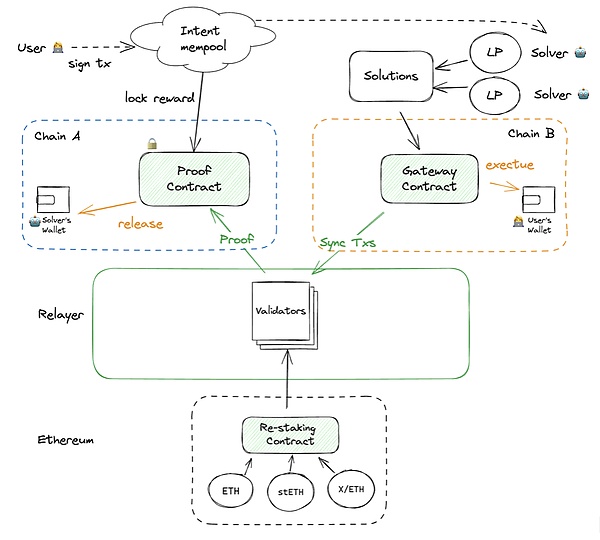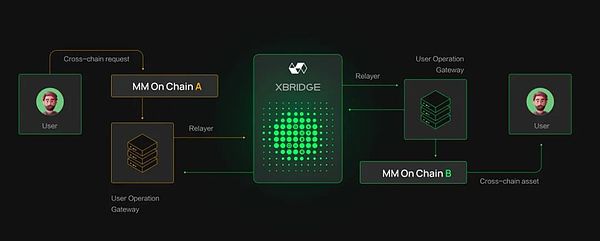
Guide
The cross -chain technology track has become the focus of hidden safety hazards in the blockchain field due to many cross -chain bridges and major losses.This track is often ignored by investors due to security issues.However, with the continuous advancement of technology, a group of emerging cross -chain agreements began to get rid of the limitations of traditional cross -chain bridges, adopting innovative cross -chain architecture to solve the core problems of cross -chain technology, that is, the so -called “impossible triangle”.The Xbridge protocol is such a model of hard work.This article will analyze the new cross -chain infrastructure protocol of XBridge, from its underlying protocol to cross -chain bridge applications such as cross -chain bridge applications.
background
Cross -chain interoperability protocols are usually called bridges. They play a vital role in blockchain infrastructure, and they are also one of the most vulnerable links.This vulnerability mainly comes from safety issues and centralized risks.As the hub connecting different blockchain networks, the bridge often becomes the goal of attackers because they usually involve the transfer of a large amount of assets.In addition, if there is a defect in the design or achievement of the bridge connection, it may also cause the loss of funds to be lost or stolen.
With the rise of modular blockchain, L2 Rollups and specific application chains, the number and diversity of blockchain are growing rapidly.These chains have promoted the significant growth of applications in the ecosystem by using their unique advantages.However, this growth also brings fragmented, decentralized applications (DAPP) services and users.This fragmentation causes a significant friction between the ecosystem and the main chain network.In the future of multi -chain, the liquidity of data and value between chains is very important because it allows more effective asset utilization, enhances interaction between different ecosystems, and supports wider innovation and user participation.
The Xbridge protocol is designed to cope with these challenges.It is not only aimed at solving the fragmented problems in the blockchain ecosystem, but also focused on improving the safety and stability of the bridge connection.By bringing together users, liquidity and interactive activities from various blockchain ecosystems, Xbridge is committed to solving the problem of mobility, application services and user participation in the web3 multi -chain environment.It creates a more secure, efficient and user -friendly bridge environment, so that data and value can flow smoothly between multiple blockchain, thereby promoting the development and innovation of the entire blockchain industry.
Solution
Xbridge is an innovative decentralized cross -chain infrastructure. It not only provides standard cross -chain bridge applications, but also introduces technical solutions centered on intention -centered, achieving a more advanced “intended cross -chain” function.The core of this function is not only the transfer of assets, but also allows users to transfer complex operating intent and logic between different blockchains.
Compared with the traditional cross -chain bridge application, the uniqueness of Xbridge is its two -layer structure:
The underlying cross -chain protocol and the application layer built on the agreement.This layered architecture makes cross -chain operations more flexible and secure, allowing users to achieve complex cross -chain interaction while maintaining capital security.
The underlying agreement is responsible for handling the safe cross -chain transmission of assets and data to ensure that transactions between different blockchain networks can be carried out quickly and safely.On this basis, the application layer of Xbridge focuses on realizing the specific intentions and operations of users, such as transaction execution, smart contract interaction, etc., which further enriches the application scenario of cross -chain technology.
In addition, this innovative architecture of Xbridge effectively separates the flow of funds from cross -chain operation logic, which not only improves the security of transactions, but also provides users with a richer and flexible cross -chain interactive experience.In this way, XBridge not only solves the restrictions of traditional cross -chain bridges, but also opened up a new realm of blockchain interoperability.
1. Decentralized cross -chain protocol
There are three types of solutions in the current cross -chain protocol field:
-
COSMOS’s IBC consensus light client has high security and minimum trust
-
Most of the methods such as Wormhole, Layerzero, and Axlar based on verification -based methods — are verified by a group of verifications in the chain
-
Optimistic message system -Nomad Bridge is one of the most prominent -relying on the validity check in the chain during the dispute window, similar to Optimistic Rollups
Each method has its advantages and disadvantages, seeking balance between speed, cost, and safety. However, they still face challenges that improve cross -chain efficiency and reduce costs while ensuring enough safety.
The Xbridge protocol came into being in this context, aiming to solve the above balance problems more effectively.Xbridge Protocol is a cross -chain protocol that uses any message to pass AMP (AMP).The protocol determines the executor of the target chain and the specific CALLDATA on the source chain.The traditional AMP protocol is facing the challenges of large data transmission, high cross -chain transaction costs, and underlying security verification issues, especially when the trust issues involving Oracle and Relayer.
To cope with these challenges, Xbridge introduced the RestAKing mechanism, which is a new type of crypto economic security.This mechanism enables XBridge to use the main network of Ethereum to achieve decentralization, security and reliability of cross -chain data transmission and verification on the consensus layer.In addition, Xbridge also constructs Ultra Light Node in the AVS layer of the RestAKing architecture to achieve end -to -end data transmission, simplify the deployment process and improve transmission efficiency.The ultra -light node has inherited the security of Ethereum networks based on the consensus based on RestANGING.
XBridge further improves cross -chain efficiency and reduces cost by introducing the intention -centered solution.The protocol creates a unique working framework (below), which includes two key roles: decentralized as a city merchant (DMM) and Solver.XBridge decoupled the DMM and Solver of the target chain from the protocol. After the user’s intention was on the chain, the solver provided the specific callData on the target chain.This method significantly reduces data transmission volume, thereby reducing the cost of cross -chain transactions.In addition, Solver’s intervention on the target chain makes the cross -chain protocol more efficient, and the operation of users can complete it at a lower cost.
>
2. Fusion account abstraction (AA) function cross -chain bridge application
The XBridge cross -chain bridge application provides a unique and innovative cross -chain solution through an account abstraction (AA) function.Unlike the traditional cross -chain bridge dependence on its own capital pool, XBridge abandons this model and introduces decentralized as a city merchant (DMM) to provide multi -chain liquidity.This design not only improves the efficiency of capital flow, but also greatly reduces the risk of hacking of the capital pool.
>
The advantage of using account abstraction
-
Personalized cross -chain transactions: AA allows XBridge to realize highly programmability of cross -chain execution and provide users with customized cross -chain experience.
-
Flexible asset management: Through account abstraction, XBridge completely decoupled asset management and cross -chain trading logic, increasing the flexibility and security of the system.
-
Improving user experience: Users can enjoy a smoother and personalized cross -chain operation without worrying about complex funding pool management or security risks.
Cross -chain case 例
The innovation of Xbridge is its intention -based cross -chain mechanism, which allows decentralized to use its own assets to pay for users to ensure that users quickly receive cross -chain assets on the target chain.This method has greatly improved the execution efficiency of cross -chain transactions.In addition, the programmable characteristics of Xbridge make the user’s cross -chain operation more flexible and efficient: the user’s multiple small cross -chain transactions can be merged into a large amount of transactions to reduce the handling fee, or to split and distribute a large amount of transactions and allocate intelligence and allocate.Perform different DMMs to optimize the use of liquidity and reduce costs.This design not only reduces the cost of users during cross -chain operations, but also greatly improves the overall user experience.
Industry innovationBleak
Xbridge is not only the industry’s first bridge application for cross -chain execution, but also the combination of its agreement and bridge application, which can connect any information or assets and has programmable.This intentional interoperability solution provides the ability to program cross -chain logic in cross -chain environment, which is a pioneering and advanced practice in the current field of cross -chain technology.
XBridge has not only provided more efficient and safer cross -chain solutions through its unique cross -chain bridge application, combined with account abstraction and decentralization, but also provided more efficient and safer cross -chain solutions.Significant results.The separation of this capital flow and cross -chain protocols and programmable cross -chain logic marks a major breakthrough in XBridge in solving existing cross -chain technology challenges.
XBridge showed its unique advantages in comparison with the outstanding cross -chain protocols such as Layerzero and ChainLink.Layerzero uses a combination of the prophet (Oracle) and Relayers to confirm the effectiveness of cross -chain transactions, which requires the application to build based on its protocol, rather than just connecting existing blockchain applications.Although Layerzero provides options for customized verification libraries, Oracle and Relayer, this still depends on specific implementation to achieve decentralization.In addition, Layerzero’s processing speed is limited by the execution time of cross -chain Relayer and Verifier, which may affect the user’s experience on the target chain.
ChainLink proposes Chainlink CCIP, a cross -chain interoperability solution that has not yet been launched.Similar to Layerzero, CCIP relies on multiple signatures to verify, sort and pass chain messages.CCIP’s core depends on the Chainlink’s prophecy machine, which allows these prediction machines to include the data reference source of ChainLink.
In contrast, Xbridge uses the RESTAKING mechanism and ultra -light node, which not only improves the degree of decentralization of its agreement, but also reaches the same security level as the Ethereum network.This mechanism allows Xbridge to achieve security consensus in a lighter way. Compared with the complex consensus layer required by Layerzero and ChainLink, Xbridge provides a more efficient and secure solution.This makes XBridge have a significant advantage in the competition of cross -chain protocols, especially in providing fast, secure and user -friendly cross -chain experience.
Summarize
XBridge broke through the traditional boundaries in the field of cross -chain technology. It not only provided revolutionary solutions in terms of safety, cost, and efficiency, but also introduced the new dimension to cross -chain programming by introducing intention -centered working frameworks.EssenceThis innovation has greatly enhanced the user’s cross -chain interoperability experience and paved the way for the widespread application of Web3.The modular route diagram of XBridge further strengthens the flexibility and ease of use of its protocol, and decomposes the core components (including verification layers, communication layers, execution layers, settlement layers, and application layers) into an independent module, which is convenient for other applications to easily integrate and easily integrate and integrate with other applications.Use its agreement.This design is conducive to the construction and development of its ecosystem.
In addition to its efficient cross -chain bridge application, the underlying protocol of XBridge also has significant business scalability.Developers can build various applications above their agreements, such as cross -chain transactions, cross -chain grid transactions, cross -chain quantitative transactions, etc.This scalability not only provides developers with extensive innovation space, but also enables XBridge to flexibly adapt to the new demand and opportunities of the market.Taken together, XBridge not only optimizes the existing cross -chain bridge applications, but also explores new possibilities for future blockchain innovation and applications.
>








